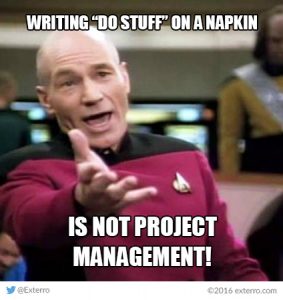
In case you’re just joining us, we started talking about whether you have the skills to create eLearning internally, in part 1. Then, whether creating eLearning internally is the right business strategy, was the focus of part 2. After answering these questions about your resources, team skills, capacity, and organizational focus, it’s time to give the FINAL answer to the BIG question, “Am I going to use my internal team for eLearning or should we outsource and let our team focus on maximizing what they do best?” If you’ve made it this far in the series, it seems you’re still considering hiring an eLearning partner (impressive deductive reasoning, huh?).
Once you’ve made the decision to find an eLearning partner, it’s important to find the RIGHT partner. Do you want to hire an independent freelancer to fill a seat? Do you want to hire a staffing agency to recruit a team for you? Or do you want to hire an eLearning vendor to be a full-spectrum eLearning partner? Regardless of your staffing model; keep in mind that to be a good fit, whoever you select needs to be able to deliver what you need, and you need to be confident that you can trust them. Let’s take a look at some of the crucial things to consider when looking for an eLearning partner.
Does their work look like something your learners and stakeholders will respond to?
The most important aspect of selecting a vendor, is finding someone who will create great training for you. Will your learners be engaged and increase their performance from the new courses? Will the project stakeholders look at you with reverence due to the overwhelming success of the project? Obviously the stakes are high, so how do you ensure success? “The best predictor of future behavior is past behavior.”
To that end, check out work samples from any prospective vendors. This can include screenshots or samples on their website, but really should include a live demo of courses in action. This gives you first hand exposure to the types of courses they have created in the past. It also lets them explain to you not only why they “look cool” but also what about them made them productive learning experiences. Make sure that what your prospective vendor thinks is awesome meets your definition of awesome.

The bottom line: Do their samples align with your requirements? Is the quality good enough for your organization? Is it too good (also read: too expensive) for your needs? Like food, or cars, or houses, everyone has their own idea of what’s good. Make sure you align with a vendor that has a track record of creating training that meets the needs of your organization.
Does their personality match your style and the vibe of your culture?
You may not expect me to say this, but we’re not the perfect vendor for every customer. And guess what, you’re not the perfect customer for every vendor. Spend time making sure you’re a good match for whoever you choose to work with.

Obviously this starts with the quality of work they produce. Does it represent how you want your work to look? But it’s more than that, especially if you’re looking for something more than a one-off relationship. Get to know the values and approach of the vendor, and make sure they line up with yours. For example, we use these principles to help define our training priorities. It doesn’t tell you everything, but it should help you understand how we define our work.
You also need to identify what your goals are from the process, beyond the actual course. This can be particularly important if you’re relatively new to eLearning and hope to gain experience along the way. If you’re experienced and want someone to get in and get out with no frills, that’s one type of experience. But if you don’t know your butt from an eLearning course, it’s reasonable to hope your vendor will mentor you through the process. If this is you, make sure you understand how experienced and willing the vendor is to not only create your course, but also to empower you along the way.
The bottom line: Make sure you “like” whoever you choose to work with. There are a lot of hours and a lot of collaboration that goes into almost any eLearning project. If you find your vendor annoying, you could be in for a long haul.
Are training services just one of the services they provide?
There are a lot of companies who’s background is not in training, but they’re jumping onboard eLearning creation. Tons of companies feel the need to round out their offerings with ancillary services. Training, especially eLearning, should not be a tack-on to other services. So whether it’s a system install or some other business service provider, make sure you find an eLearning partner who knows and focuses on training.
The bottom line: If you implement a software solution, and that company wants to train you on their system, that’s usually pretty safe. But if you employ a company for some non-training-related solution (LMS vendor, business process consulting, etc.), and they try to cross-sell you eLearning that isn’t related to their solution, think twice. Good training is hard, so make sure you use people who focus on it directly, not as an up-charge.
Can they provide multiple training-related services?
This question differs from the “multiple services” one above because here we’re talking about multiple training-specific services. Companies that are solely focused on training can afford to diversify into multiple design and delivery modalities. That said, if you already have a team of people and you only need overflow assistance in one specific area (like a Storyline developer), then you can likely ignore this section.
For everyone else, it’s good to cultivate a relationship that can serve multiple needs as your requirements change. If you’ve chosen to go the freelance route, this may mean striking up multiple relationships. This guy does ID work, this guy creates graphics, this girl does Storyline development. Whatever. Otherwise, if you pick the right vendor, they may be able to provide all of these services at the level you need them. The added benefit of a vendor relationship is there’s only one point of contact and a single responsible party keeping things coordinated.

However you source this expertise, it’s good to vet the resources before you’re in a pinch. Find the right people for the different project needs you typically have. When something crops up unexpectedly (you want this new course completed by WHEN?!?!) hopefully you’ll already know who you’ll pull in to help out. We have many of this type of relationship. Even if the client does most of their day-to-day training work internally, they know the areas they can turn to us for overflow. One project it might be ID work, another we’re strictly Storyline development, and others are “we don’t have time to create this course, can you take it” type situations. When the crunch is on, they aren’t messing around figuring out who’s qualified to take the work.
The bottom line: Not every project has the same needs or experiences the same bottlenecks. Finding a vendor that has qualified personnel in multiple areas gives you a ton of flexibility, without having to find, vet, and maintain multiple vendor relationships.
Do they follow a comprehensive design / development process?
Even a simple eLearning project has a lot of moving pieces. You need to make sure your prospective eLearning partner follows a sensible and organized process. There isn’t a single, correct process to follow, but we follow this, which has a simple and logical progression through the project stages. Make sure whoever you select follows something that makes sense to you, and can align with your team’s approach.
Regardless of the specific methodology, can your outside resource be flexible and adapt on the fly? That may not matter as much if you’re looking for someone to help with a one-off project. But, if you’re looking for a partner who can help with recurring projects, you need to trust them, their work process, and their capabilities. This will give you confidence they know what they’re doing, and it also helps to set proper expectations with what’s upcoming.
The bottom line: While there isn’t a single way to run an eLearning project, make sure your prospective vendor has a plan, and appears ready and able to follow it. Even modest eLearning projects can incite chaos, so make sure to partner with someone who can demonstrate the ability to keep things on track.
How do they manage their projects?
Depending on the project size and complexity, you may or may not need a dedicated project manager. Find out how they go about coordinating project resources, tracking statuses, and ensuring everyone is on the same page.

We use a tool called Teamwork. This can house everything to do with the project, including all the tasks and timelines, with the ability to display a Gantt chart. We give all project stakeholders access to the portal so they can check the current status at any time.
The bottom line: There are many ways to accomplish project management and transparency effectively, with a variety of different tools. It doesn’t matter so much what tool your vendor uses. It matters that they use something that can keep everyone coordinated and provides visibility to all interested parties.
Will you own the course and the assets at the end?
This should be a given, but make sure your vendor intends to provide you with the source files at the conclusion of the project. This is a course built for you, with your content, make sure you own it at the end. As an example, we typically have a project close meeting to discuss how everything went, lessons learned, etc. Part of this is the official hand-off of materials. Turning over source files earlier can introduce version control issues, so make sure there is an official point where everyone knows who possesses the working files.
The bottom line: Your project, your files.
What eLearning development tool will they use?
If you’re definitely going to turn your eLearning project over to an outsource partner, and have them do 100% of the work, this is less of an issue. However, if you intend to take some ownership of maintaining the courses after the initial development, this matters a great deal. In either case, I would suggest sticking to the mainstream tools (Articulate, Adobe, Lectora, etc.). Even if you aren’t going to touch the files yourself, you want to make sure you can find other qualified developers if you need to change partners.
That said, I would strongly encourage you to become involved enough to make at least small edits yourselves. If you need to call your vendor every time you need a small text change, you’ll be spending more money than you should. Tools like Articulate Storyline are a great balance between being approachable and functionally robust. This allows your vendor to create great courses, and you could still learn the tool enough to make minor edits.
If you don’t already know how to use any of the eLearning tools, depending on your selected eLearning partner, they may be able to provide training. There are certainly lots of online resources for learning eLearning tools from scratch, but if you don’t envision being the primary developer, a custom curriculum could center around the functional roles you’ll actually be performing.
The bottom line: Stick to the mainstream tools. And even if you don’t aspire to develop your courses, learn the software enough to do your own maintenance. A well developed course can be created in a way that’s easy for you to maintain. If you’re gonna spend money on outsourcing, use it for things you can’t do yourself.
Finding the Perfect eLearning Partner
As you can see, there’s a lot that goes into figuring out who to work with. Projects can range from a few thousand dollars to a few hundred thousand dollars, if they’re big enough. Because of this, trust is paramount when it comes to an eLearning partner. Even if you only have a small, short-term project, find someone you can see yourself working with long-term. Establishing a mutually beneficial relationship that you can turn to at a moment’s notice can be invaluable when you’re in a pinch.
So, use these topics to evaluate anyone you’re considering as your next eLearning vendor. And if somehow you’ve come this far, and can’t help thinking how awesome we sound (did I take the words right out of your mouth?), I hope you’ll consider using our services here at ThinkingKap.
